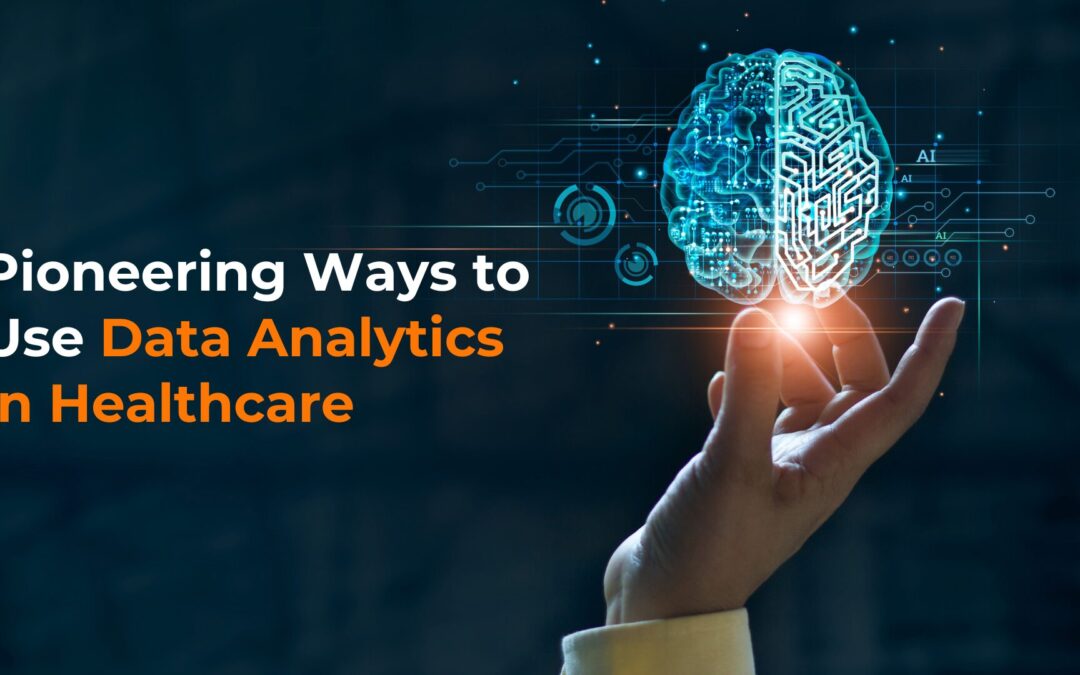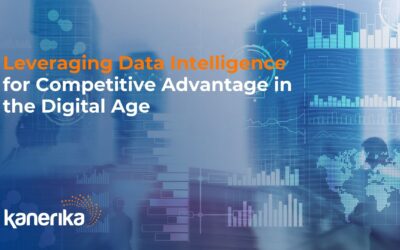The global big data healthcare market expanded to $22.73 billion in 2023, recording a CAGR of 11.9%, and is expected to reach $53.96 billion by 2027 with a projected CAGR of 24.1%. We are here to shed some light on the opportunities and challenges of data analytics in healthcare. Let’s begin!
Despite 2022 facing temporary disruptions such as economic sanctions and inflation, adopting big data solutions in healthcare has empowered organizations to make informed decisions and enhance healthcare management. Let us uncover the opportunities and challenges of data analytics in the healthcare industry for 2023, alongside the top 10 examples of big data applications in healthcare that can benefit medical-based institutions.
Big Data in Healthcare – What Does it Mean?
Big data in healthcare refers to the massive volume of information collected through digital technologies, enabling better management of patient records and hospital performance.
While big data delivers a vast amount of information, data analytics extracts insights and patterns from this data to improve patient care and operational efficiency.
Utilizing data analytics unlocks the potential to prevent epidemics, reduce costs, and improve patient care.
Moreover, Integrating data from various sources like patient portals, EHRs, wearable devices, and government agencies poses challenges. Still, technological advancements allow for more efficient data collection and analysis, leading to proactive problem-solving and improved healthcare delivery.
Challenges Of Data Analytics In Healthcare
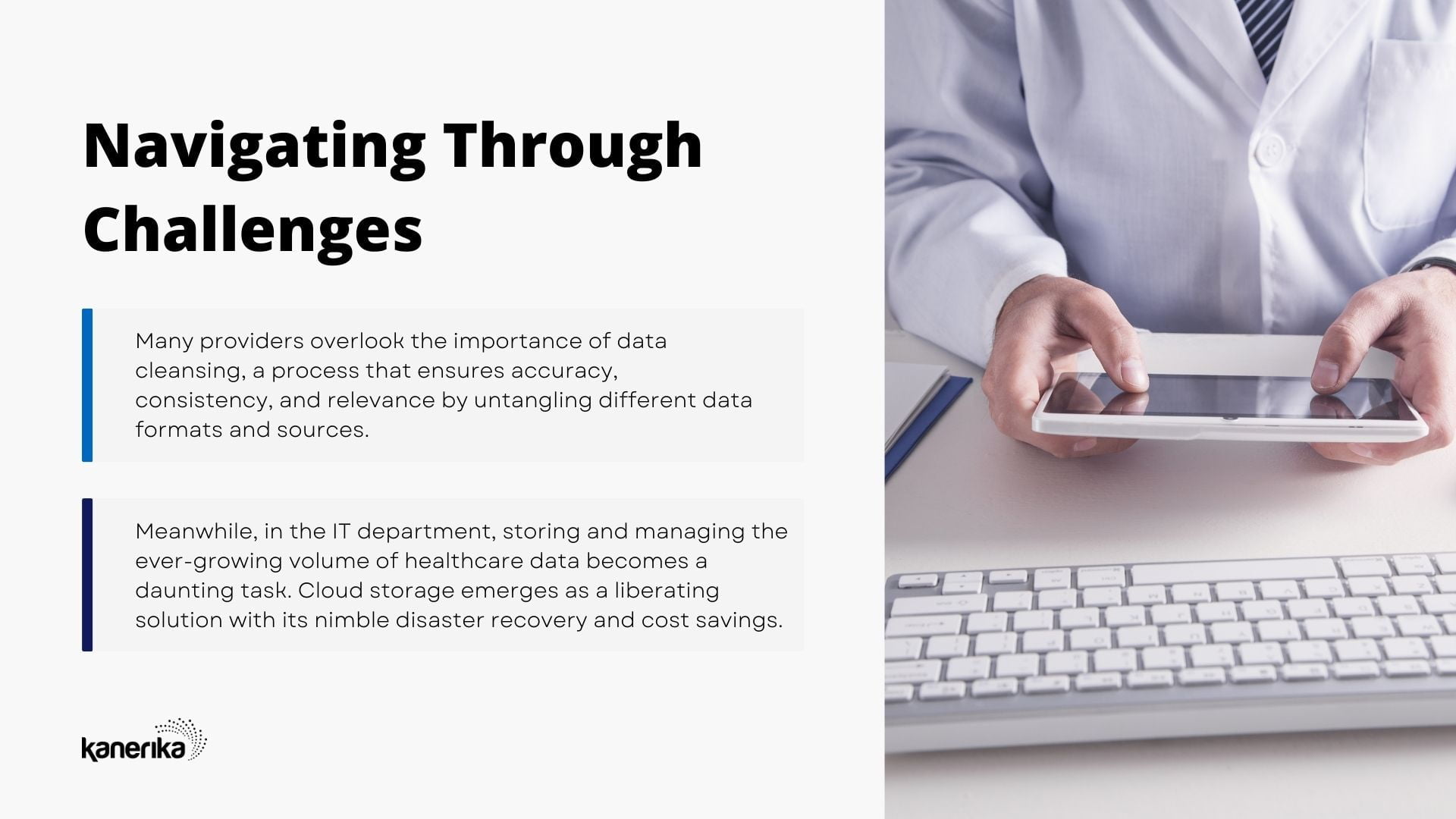
In the world of healthcare, big data presents both challenges and opportunities. Imagine a bustling clinic where cleanliness is crucial for patient safety. But what about data cleanliness? Many providers overlook the importance of data cleansing, a process that ensures accuracy, consistency, and relevance by untangling different data formats and sources.
Meanwhile, in the IT department, storing and managing the ever-growing volume of healthcare data becomes a daunting task. Traditional on-premise data centers have limitations, leading to data siloes. Cloud storage emerges as a liberating solution with its nimble disaster recovery and cost savings.
Additionally, unlocking the treasure trove of data through queries and reporting becomes a transformative experience. Overcoming data siloes and standardization challenges empowers organizations to gain profound insights and make informed decisions.
Similarly, captivating visualizations turn overwhelming data into digestible insights. Colorful charts and illustrations enable clinicians to absorb information quickly, leading to better decision-making.
Data, like a living organism, requires constant updates to remain relevant. Automation and careful monitoring ensure data freshness without compromising quality or integrity.
However, these challenges rarely ever go unattended by the immense opportunities that are unlocked via data analytics in the healthcare sector. Let’s discuss some use cases next!
Opportunities Of Data Analytics In Healthcare
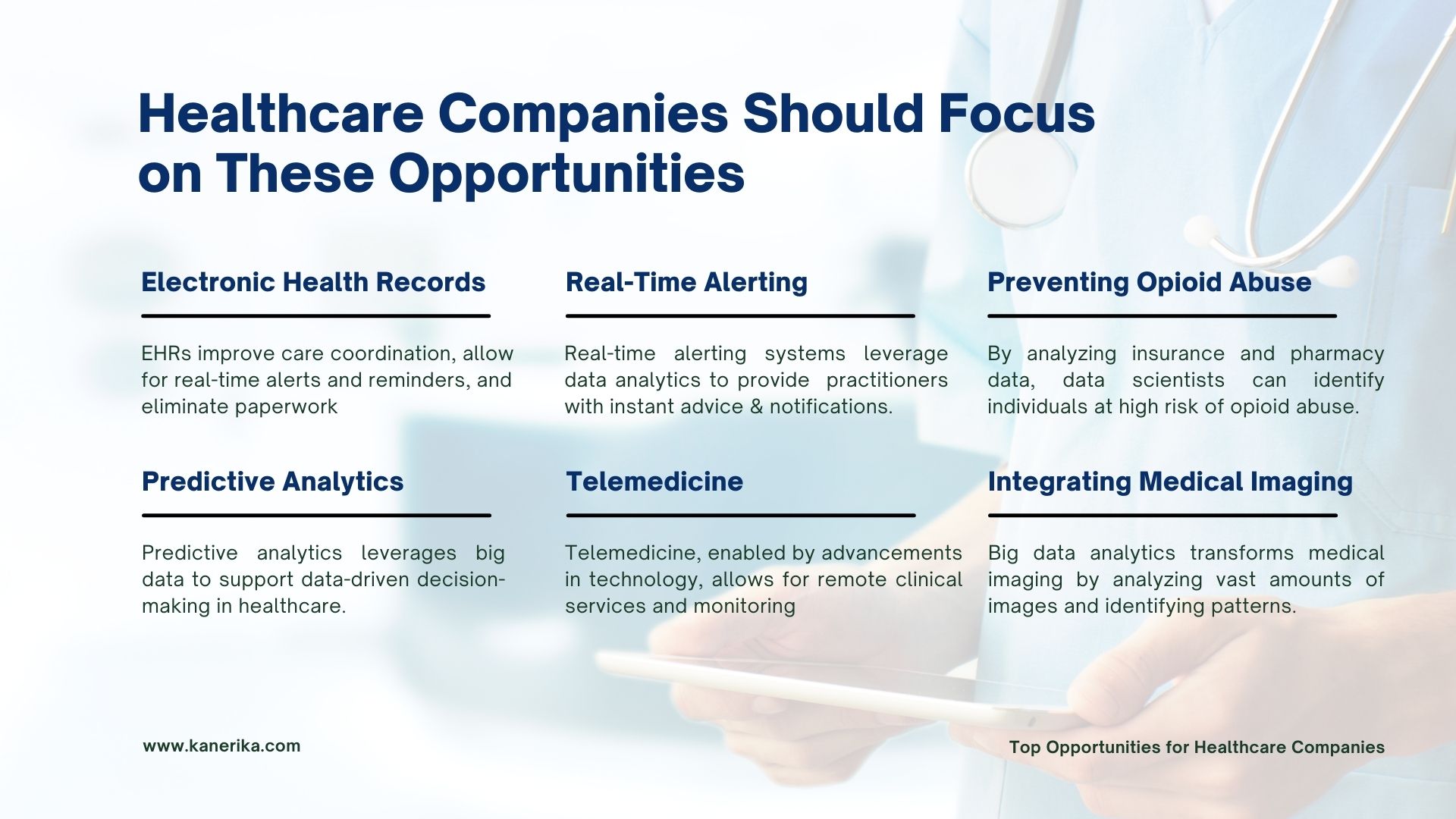
Patient Predictions for Improved Staffing
Big data is revolutionizing staffing in healthcare facilities. By analyzing years of hospital admissions records and utilizing machine learning algorithms, hospitals can accurately predict patient loads on a daily and hourly basis. This enables better resource allocation, ensuring optimal staffing levels and improved patient care.
Electronic Health Records (EHRs)
EHRs are the most widespread application of big data in healthcare. These digital records contain comprehensive patient information, including medical history, allergies, and test results. EHRs improve care coordination, allow for real-time alerts and reminders, and eliminate paperwork. While adoption rates vary globally, successful implementations like Kaiser Permanente’s HealthConnect have demonstrated improved outcomes and cost savings.
Real-Time Alerting
Real-time alerting systems leverage data analytics to provide healthcare practitioners with instant advice and notifications. Wearable devices collect continuous health data, which is then transmitted to the cloud for analysis. If concerning health trends are detected, such as elevated blood pressure, doctors receive live alerts and can intervene promptly. Real-time alerting enhances patient monitoring, disease management, and early intervention.
Enhancing Patient Engagement
Big data enables personalized patient engagement. Smart devices and wearables track various health metrics, empowering individuals to take control of their well-being. This data can be combined with other information to identify potential health risks and enable proactive interventions. Incentives from health insurance providers further encourage individuals to lead healthy lifestyles and reduce unnecessary doctor visits.
Preventing Opioid Abuse
Big data analytics plays a crucial role in combating the opioid crisis. By analyzing insurance and pharmacy data, data scientists can identify individuals at high risk of opioid abuse. This information helps healthcare providers intervene early and prevent addiction. Leveraging data-driven insights contributes to saving lives and reducing the financial burden caused by opioid abuse.
Using Health Data for Strategic Planning
Analyzing health data enables informed strategic planning. Care managers can identify factors that discourage people from seeking treatment by analyzing check-up results among different demographic groups. This information helps optimize the allocation of medical services to areas with the greatest need, improving access to care and overall health outcomes.
Big Data in the Cancer Moonshot Program
The Cancer Moonshot program harnesses the power of big data to accelerate progress in cancer research. Analyzing large datasets, including treatment plans and patient outcomes, helps identify trends and treatments that yield the best results. Sharing and analyzing data across institutions enable researchers to uncover breakthroughs and develop more effective cancer treatments.
Predictive Analytics in Healthcare
Predictive analytics leverages big data to support data-driven decision-making in healthcare. By analyzing vast amounts of patient data, predictive models can identify individuals at risk of certain conditions, enabling proactive interventions. Predictive analytics enhances patient care, treatment planning, and resource allocation.
Reducing Fraud and Enhancing Security
Big data analytics assists in preventing fraud and enhancing security in healthcare. By analyzing network traffic and monitoring behavior, organizations can identify potential cyber-attacks and mitigate security threats. Analytical tools streamline insurance claim processing, reducing fraud and ensuring faster payments.
Telemedicine
Telemedicine, enabled by advancements in technology, allows for remote clinical services and monitoring. It improves access to care, reduces costs, and enhances patient convenience. Telemedicine also integrates with predictive analytics, enabling proactive interventions and preventing hospitalizations.
Integrating Big-Style Data with Medical Imaging
Big data analytics transforms medical imaging by analyzing vast amounts of images and identifying patterns. Algorithms can extract valuable information from images, assisting radiologists in diagnosis and treatment planning. This integration improves efficiency, accuracy, and the overall role of radiologists in healthcare.
Challenges and Considerations in Healthcare Data Analytics
Data Privacy and Security
Ensuring patient data is protected while enabling its use for analytics is a critical challenge in healthcare data analytics. Striking a balance between data accessibility for analysis and maintaining strict privacy standards is essential to build trust with patients and comply with regulations like HIPAA. Implementing robust data encryption, access controls, and audit trails is necessary to safeguard sensitive information.
Data Quality and Standardization
Addressing inconsistencies and ensuring data accuracy across healthcare systems is crucial for meaningful analysis. Standardizing data formats, cleaning datasets, and implementing quality control measures are necessary to ensure the reliability and integrity of the data used in analytics. Establishing clear data governance policies and investing in data stewardship roles can help maintain data quality throughout the analytics lifecycle.
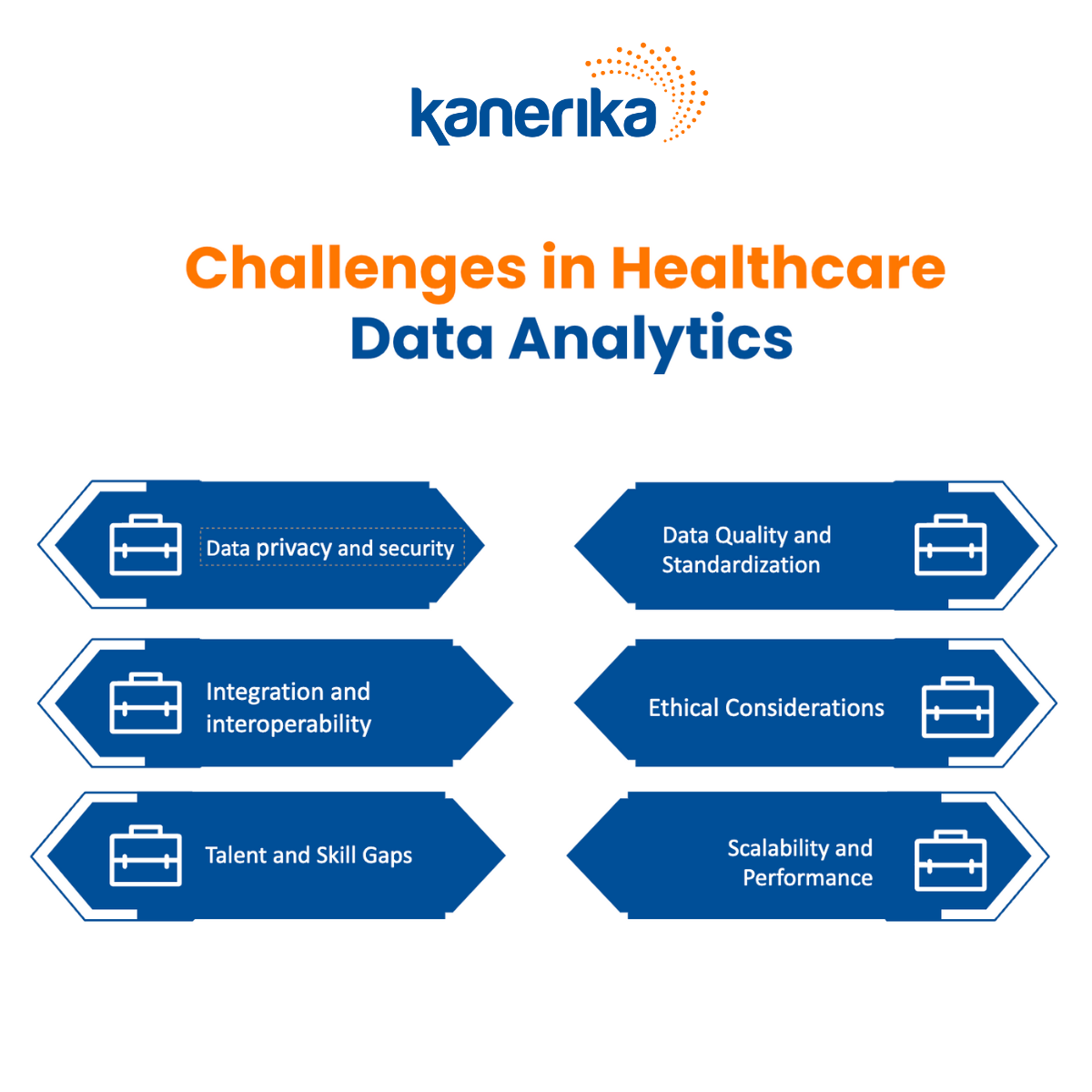
Integration and Interoperability
Facilitating seamless data exchange between different healthcare technologies is a significant consideration. Interoperability challenges arise due to disparate systems, varying data formats, and incompatible protocols. Overcoming these barriers is essential for creating a unified data ecosystem for effective analytics. Adopting common data standards, such as HL7 FHIR, and leveraging middleware solutions can help bridge the gap between systems and enable data sharing.
Ethical Considerations
Maintaining transparency and fairness in the use of data analytics in healthcare decisions is paramount. Ethical considerations include issues such as bias in algorithms, informed consent for data usage, and ensuring that data-driven decisions prioritize patient well-being and autonomy. Upholding ethical standards is crucial for the responsible application of data analytics in healthcare. Establishing ethical review boards, implementing algorithmic audits, and fostering a culture of responsible data use can help address ethical concerns.
Talent and Skill Gaps
Bridging the talent and skill gaps in healthcare data analytics is a significant challenge. The field requires a unique combination of domain expertise in healthcare, data science skills, and business acumen. Investing in training programs, attracting top talent, and fostering collaboration between clinicians and data scientists can help address the skills gap and build a strong analytics workforce.
Scalability and Performance
As the volume and complexity of healthcare data continue to grow, ensuring the scalability and performance of analytics solutions is crucial. Handling large datasets, processing real-time data streams, and delivering insights at the point of care require robust infrastructure and optimized algorithms. Adopting cloud computing, distributed processing frameworks, and edge computing can help address scalability challenges and enable efficient data processing at scale.
Explore Healthcare’s Transformative Future With Kanerika
The implementation of big data analytics allows patients an enhanced quality of care both inside and outside healthcare facilities. Additionally, healthcare providers will be able to compile comprehensive patient profiles, enabling accurate care & treatment. Both the challenges and opportunities of data analytics in healthcare hold significant promise in steering the industry toward a future that is more efficient and cost-effective.
At Kanerika, we leverage big data in healthcare software to introduce technology solutions that streamline and enhance the productivity of healthcare organizations of any scale.
Enhancing Business Performance in Clinical Trials
A leading global provider of clinical research services sought to improve data processing efficiency. Manual methods limited their ability to handle diverse healthcare data for research on diseases like COVID-19. Big data analytics offered a solution, simplifying data extraction, cleaning, and preparation for research, while enabling reusability, customization, and adaptability for future projects with various data formats.
Their Challenges:
- Manual SAS programming caused delays in data conversion, hampering productivity
- Extracting and converting data from diverse sources limited the analysis capabilities and affected overall decision-making
- Inefficient data cleaning compromised quality, undermining research outcomes
Kanerika’s Solutions:
- Transformed large and complex datasets efficiently using Trifacta, boosting productivity and accuracy
- Streamlined reporting and data preparation with Trifacta’s UX, improving decision-making and time-to-insights
- Seamlessly integrated Trifacta for simplified data migration, cleansing, and processing, resulting in streamlined workflows, one of the benefits of big data analytics in healthcare
FAQ
How does data analytics reduce fraud and enhance security in healthcare?
Why is data freshness important in healthcare data analytics?
How does cloud storage address data management challenges in healthcare?
What are the benefits of integrating big data analytics with medical imaging in healthcare?
How do captivating visualizations benefit healthcare professionals in data analytics?
How is big data revolutionizing staffing in healthcare facilities?
How does health data analysis inform strategic planning in healthcare?
How does data analytics contribute to the prevention of opioid abuse in healthcare?

